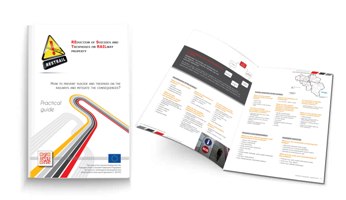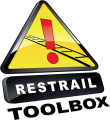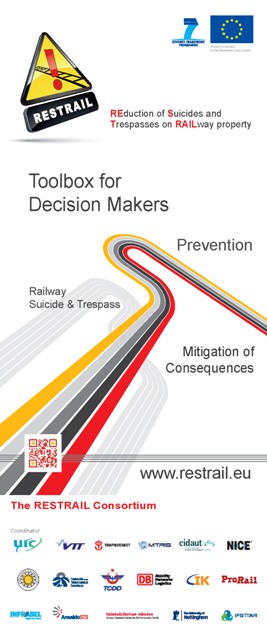Background
Railway suicides and trespassing accidents represent 89% of all fatalities occurring within the railway system, resulting in more fatalities than train derailments and collisions together (ERA , 2016). They lead to human and economic consequences with considerable impact on the whole society. Beyond the human loss, suicide and trespassing accidents cause important delays, as well as trauma and stress to the railway staff and discomfort to passengers. In this context, the key objective of the RESTRAIL project is to provide guidance about the implementation of preventative and mitigation measures against suicide and trespass and to disseminate this information among the end-users for a better exploitation of the results of the project.
You may also wish to check the:
- Scientific summary of the project published in the European Transport Research Review
- RESTRAIL ’success story’ on the European Commission website, or the article (pp 22-23) produced by the Transport Research and Innovation Portal (TRIP) for DG MOVE
- RESTRAIL permanent factsheet on the European Commission website
Find us on social media: look for #RESTRAIL to see the most recent updates and news about the long-term exploitation of the RESTRAIL results.
Who can use this Toolbox
It is designed particularly for RUs , IMs and station managers, but can be used by all people involved in the process of choosing appropriate preventative or mitigation measures (e.g. decision-makers), as well as safety specialists working with the RUs and IMs or local authorities.
Assumptions about end-users
Before the development of this Toolbox a number of assumptions were made about how decision-makers (e.g. RUs and IMs ) may want to make decisions about the implementation of the measures. These helped to generate the basic requirements of the guidance materials included in this Toolbox.
- RUs and IMs would make decisions based on a good understanding of the problem they are facing in order to save as many lives as possible on the railway networks and maintain a high standard of service punctuality.
- There may be different ways to approach the task of selecting the different preventative and post incident consequence mitigation measures. Therefore, any guidance or tools should be flexible, accounting for the fact that users may have different levels of expertise or experience in this area of work. The guidance and associated tools should therefore help the end-user by providing a structured approach to solve the problem at hand and provide clear options to select an appropriate preventative measure. The expert may wish to short-cut some parts of the process and have access to detailed data that they may want to use in helping them to make their decision.
- The effectiveness of measures is another key issue for RUs and IMs . In other words the Cost-Benefit Analysis (CBA ) for a measure needs to be positive in order for it to be considered for implementation. Therefore, the preventative and mitigation measures included in the guidance material should be based on criteria on which a measure performs strongly or poorly or details of the likely effect of implementing a particular measure on the numbers of suicide or trespass events. Accordingly, the measures proposed in this Toolbox are based on a detailed assessment process and expert ratings on different evaluation criteria: (1) durability of effects, (2) costs and benefits (based on expert judgment and not on calculation of the cost/benefit ratio), (3) integration with other policy measures, (4) impact on railway operations, (5) impact on people and jobs; (6) technological issues; (7) environment; (8) acceptance and (9) transferability issues. Total scores on the various evaluation criteria were computed for each measure separately in the context of suicide and of trespassing. According to the total score each measure was classified as recommended (best scores), or promising (good scores) in order to provide a user-friendly rating which may facilitate an effective decision.
Organisation of the Toolbox
Based on the previous assumptions, the Toolbox includes two parts: a general guidance and a specific guidance.
- The first part provides general guidance through a multistep approach which structures the analysis of a problematic situation. The question answered by the general guidance is how to analyse a problem and choose the optimal preventative or mitigation measure(s)? The general guidance consists of six steps: (1) describing and understanding the problem; (2) in-depth analysis of the target situation; (3) selection of the most suitable measures; (4) planning the implementation and evaluation; (5) implementation of the measures; and (6) evaluation of the outcomes. For each of these steps the Toolbox provides a checklist of proposed actions and information to be collected in order to assist the user in the decision-making process. Consequently, this part of the Toolbox may provide a general methodology for the inexperienced end-users who deal with a suicide or trespassing problem, as well as with post incident consequence mitigation difficulties. For the experienced end-users, it can be simply used as a checklist in the problem-solving process.
- The second part includes the specific guidance, providing details about the implementation of a variety of measures. The question answered by the specific guidance is how to implement the selected measure(s) in order to minimise the shortcomings and enhance the expected effect? This part of the Toolbox provides the end-user with a wide list of preventative and mitigation measures, implementation tips, examples, empirical evidence for effectiveness and other useful details which may be important during the implementation phase.
So far, 70 different specific measures have been selected in the Toolbox as recommended solutions for prevention or mitigation, and some of these have been pilot tested during the project. For clarity and pragmatic purposes, these measures were grouped into fewer subsets (i.e. 25 families of measures) sharing common typologies or common effect mechanisms to influence suicidal and trespassing behaviours. Consequently, families may include an unequal number of specific measures which varies between 1 and 6. It is also important to note that the details provided in the Toolbox vary considerably between measures. For some families and subsequent specific measures the information provided in the specific guidance is limited compared for example to the measures which were pilot tested during RESTRAIL .
Evaluation and improvement
The development process of the Toolbox has been iterative and user-tested so that its usefulness and usability improve. The working versions were periodically sent to partners for comments and feedback and the drafts were improved based on the results of systematic assessment procedures. During the project, the main evaluation was done though two joint dedicated workshops during the RESTRAIL Mid-term conference held at UIC Paris on 12 June 2013. Since the end of the project, other workshops have been organised in more than 10 different countries (both EU and non-EU). Such evaluations have enabled us to make adjustments in accordance with the feedback of the safety experts of RUs and IMs , other stakeholders and policy makers, during and beyond the RESTRAIL project’s lifetime.
Current and future versions
This Toolbox is an ongoing process. The content has been developed and continuously updated during RESTRAIL . The official version of the Toolbox was presented on 18 September 2014, during the RESTRAIL Final conference. Since the end of the project the content has been updated under the responsibility of UIC . The Toolbox will continue to be improved based on further information provided by RESTRAIL partners, examples of actions shared in international events and results published in the scientific literature. Contributions and examples of good practice are also expected from other stakeholders worldwide. Do you have a suggestion? Send us your feedback, contribution or question via the Contact form.
How to use the Toolbox
 The RESTRAIL Toolbox is one of the few if not the only integrated approach to analyse and prevent a railway suicide/trespass problem and to implement post-incident mitigation measures. It should be used as a “guide to best practice” rather than a standard procedure or fixed framework. It provides a systematic but flexible approach, allowing the end-users to adapt it to their specific needs in accordance with particular national / cultural problems.
The RESTRAIL Toolbox is one of the few if not the only integrated approach to analyse and prevent a railway suicide/trespass problem and to implement post-incident mitigation measures. It should be used as a “guide to best practice” rather than a standard procedure or fixed framework. It provides a systematic but flexible approach, allowing the end-users to adapt it to their specific needs in accordance with particular national / cultural problems.
This tool is not exhaustive, and neither was this its authors’ intention. It reflects the main results of the RESTRAIL project, including only the measures which have emerged as recommended or promising during the project. This explains why some possible measures are not included in the Toolbox. However, the classification system used in this tool is flexible enough to allow new measures to be added in the future.
Terms of use and copyright
This publication may be reproduced free of charge for research, private study or for internal circulation within an organisation. This is subject to it being reproduced and referenced accurately and not being used in a misleading context. The material must be acknowledged as the copyright of RESTRAIL Consortium members and the title of the publication specified accordingly. For any other use of the material please apply to International Union of Railways (UIC) for permission. Any additional queries can be directed to security uic.org.


